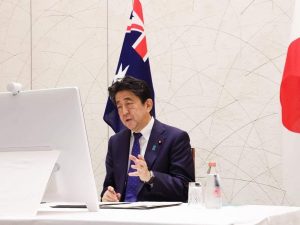Virtual summits during the ongoing pandemic don’t seem to make headlines in the same way their analog counterparts used to. Last week, Japanese Prime Minister Shinzo Abe and Australian Prime Minister Scott Morrison held a “virtual leader’s meeting” to discuss a range of issues.
Australia and Japan — countries that call each other “special strategic partners” — have been sharply converging in recent years and see eye-to-eye on a number of regional issues. Each a U.S. ally and each a member of the so-called “Quad” alongside India and the United States, regional coordination between the two countries is growing fast.
Apart from discussing the pandemic and how both countries have fared, Morrison and Abe discussed a range of regional issues, including development assistance around the region (specifically, in Southeast Asia and the South Pacific).
The two leaders focused also on the regional rules-based architecture. Though it went unnamed, concerns about China’s activities in the Asia-Pacific region were no doubt on the agenda. Australia, in particular, has faced a challenging year in its relationship with China.
The meeting also comes just a little more than a week after Morrison unveiled a major update to Australia’s 2016 Defense White Paper, putting a greater emphasis on conventional, standoff strike capabilities.
In another bit of synergy between their two countries, Abe was speaking to Morrison not long after his government moved to cancel plans to move ahead with two Aegis Ashore ballistic missile defense sites. One of the options under consideration in Tokyo to substitute for the lost capability that system might have brought to bear is the possibility of further conventional strike options too.
As U.S. allies, both Canberra and Tokyo have grown to adapt to the Trump era in U.S. foreign policy differently. But both countries are thinking more and more about autonomous defensive capabilities and the ability to sufficiently practice deterrence-by-denial, with the future role of the United States perhaps more uncertain than in the past.
The Japanese and Australian armed forces are doing more together and learning from each other too. The two countries are closer than ever in domains including intelligence-sharing and continue to increase the interoperability of their forces.
A look at the Japanese and Australian official readouts of the meeting underscores the great breadth of issues covered by the relationship today: apart from the above, the two addressed the East and South China Seas, North Korea’s nuclear program, and cooperation at multilateral fora.
In 2020’s geopolitical landscape, there’s little doubt that the Tokyo-Canberra relationship remains one to watch.

































